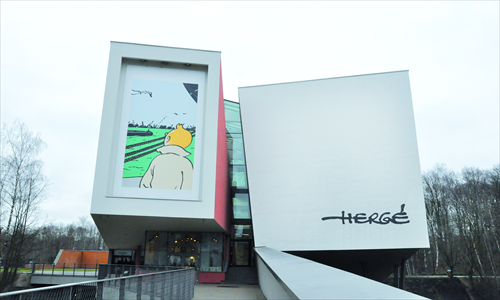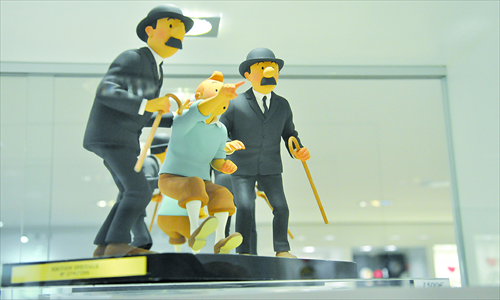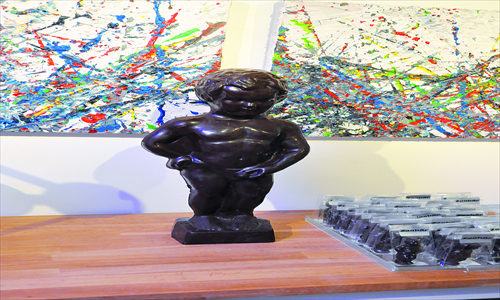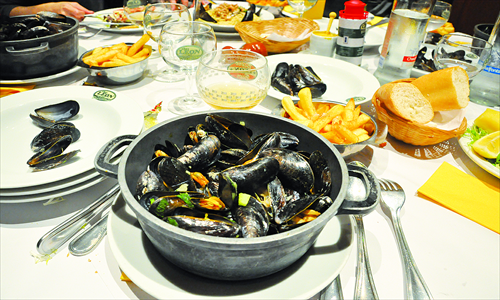When mentioning Brussels, the first thing that will undoubtedly come to your mind must be chocolate. After that, the Grand Place, Manneken Pis, Tintin, beer, waffles and frites all are must-sees and -eats, of course - but if you want to experience them all in one day, then you must work out a tight schedule and get up early to start your trip, just like I did recently in the capital of this tiny but magnificent Western European nation.

The Hergé Museum
Tintin and the Hergé Museum
After watching Spielberg's 3D epic The Adventures of Tintin, I developed a great interest in Hergé's red-haired comic-book hero, Tintin. So I chose the Hergé Museum, located in the Walloon town of Louvain-la-Neuve, only one-hour train trip away from Brussels, as my first stop.
The train was convenient and the return ticket cost only 9.8 euros, a fair price indeed. The train, which reminded me of the old Chinese green carriage-style trains, stopped almost every 10 minutes at every stop it passed, with many students and other young people getting off and usually the same number getting on. Our guide, Ludivine Destrée, with Wallonine Bruxellses Tourisme (who, it should be noted, can speak fluent Chinese), explained that the Louvain-la-Neuve and its nearby towns are full of universities.
Walk out the Louvain-la-Neuve station and pass the town center, which is just a small square, and you'll see the Hergé Museum in front of you. Interestingly, the giant irregular building, which resembles a giant ship emerging from the sea of trees and crashing into the town, is connected to the town by a wooden footbridge. The left part of the building's facade is decorated with a giant picture portraying Tintin and his favorite partner Snowy (Milou in French) while on right is the handwriting of Hergé, the pen name Belgian writer Georges Remi (1907-1983) used when creating the comic series.
Maybe due to the incessant rain during the winter season, the museum was fairly sparse. The guide suggested that the best way to visit the museum is to rent an audio guide, an iTouch-like device that leads you through the museum's most interesting areas.
Architect Christian de Portzamparc divided the space into four "landscape objects", each painted with comic scenes from Tintin's adventures in Hergé's drawing style, from Tintin in America to King Ottokar's Sceptre, and each connected via footbridge. As you walk through the space, the perspective changes constantly.
The museum's permanent area starts from the third floor, where you can lay your eyes on Hergé's original manuscripts, his inspiration for each adventure, previously-unknown small stories behind Tintin's adventures. The museum even exhibits the yellowing copy of the Belgian newspaper Le XXe Siècle from January 10, 1929, where Tintin made his first appearance in French. The comic series turned out to be so big a success that it was published in Belgium's leading newspaper Le Soir, and then into a successful Tintin magazine. These transition copies from the newspaper to the magazine are exhibited in the space.
Up to then I didn't know that the pen name Hergé came from the French pronunciation of "RG", the initials of Remi's name. When writing The Adventures of Tintin, Hergé used the adventures he experienced in many countries around the globe as primary source material, while allowing himself some artistic license over the portrayals of the countries, cities and people in his stories.
From photos and souvenirs that he acquired during his trips, and his scripts that are exhibited, I noticed that he did not have limitless resources: he made use of his personal acquaintances, newspapers, his colleagues and added plenty of elements from his own imagination.

Tintin and brothers Thomson and Thompson.
Throughout all of Tintin's adventures, he and his four-leg companion Snowy have been to China twice, as depicted in the stories The Blue Lotus and Tintin in Tibet. As the only Chinese visitor over the space of that day, I spent half an hour wondering in the showcases on the museum's second floor. In 1934, Hergé met Chinese student Chang Chong-Chen. Chang supplied much of the Chinese writing that was featured in the book and taught Hergé a great deal about Chinese culture, history and drawing techniques. He also gave a detailed description of life in 1930s China. His help was so substantial that Hergé said, "Tchang [Chang] unknowingly figured as one of the main inspirations in my life. It is he who made me conscious of the need to get the true facts on a country and to lay out a coherent story."
In one of the exhibits showcasing his pencil sketches of Chinese characters in The Blue Lotus, the writer explained that when creating the characters, he made some use of Chinese writing and poetry, describing this process as "the combination of the wind and the bone, meaning the breath of inspiration and the bone of graphic strength."
There, I also saw some Chinese poetry collections from the 1930s and some works of calligraphy, which are said to have been owned by the writer while creating the story. These Oriental artistic expression had such a hold on his imagination that he consulted them constantly while sketching out the drawings for Tintin. Throughout his life, Hergé maintained a good relationship with Chang, and as his fame grew, Hergé was even invited for an audience with Chiang Kai-shek, the leader of the Republic of China at that time, though he didn't make it due to the outbreak of World War II.
The museum will also introduce you to some of the familiar faces of Tintin's adventures. First, of course, is the lovely white fox terrier Snowy. He is quite close to Tintin and in each adventure they save each other from perilous situations. Next is Captain Haddock, one of the heroes of the Spielberg movie. The humorous, always-drunk captain is Tintin's best friend. His showcase features a great deal of objects related to him, including the model of the ship, the Unicorn, which belonged to his ancestors, and his favorite Scottish whiskey, of course.
The museum is not very big. Setting aside an hour or two for the museum on your travel plan should be adequate. The museum opens at 10:30 am from Tuesday to Friday, and at 10 am on Saturday and Sunday.

Chocolate made Manneken Pis

Mussels served at Chez Leon.

